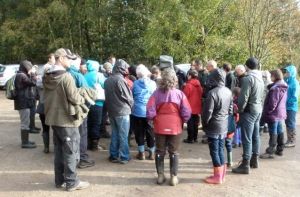FOAW note: If you want to eat fungi, buy them from the supermarket or learn from an expert. The information on this website will not enable you to identify any edible fungi.
Foray Leader: Steve Joul
Foray Attendance: estimated 40 (30 adults and 10 children).
Number of species recorded: 29.
Recording of Fungi: Mary Page and Steve Joul.
Foray Report: This fungal foray event was run for the Friends of Adel Woods and was open to the public, in the hope of attracting new members to the group. It was a dull and breezy afternoon but nevertheless a large crowd of around 40 people gathered. A small charge was made for adults but not children.
Following an introduction in the rugby club car park we walked back along Cragg Lane towards King Lane to see a large Artist’s Bracket on a mature Beech tree. We then explored Alwoodley Craggs Plantation to see what other fungi we could find.
The presence of enthusiastic families with children ensured a continuous supply of fungi to be identified with Ochre Brittlegill and Butter Cap being particularly abundant. The Deceiver lived up to its name particularly well, with a large and frilly-edged pale tan example contrasting with a smaller, rounder, reddish brown specimen.
A Dead Man’s Finger had people recoiling in horror whilst the white milk from a Birch Milkcap turned yellow on a white handkerchief as it was supposed to. An apparently munchable-mushroom proved to be the toxic-toadstool Poisonpie whilst the alarmingly-coloured Amethyst Deceiver was in fact an example of an edible species.
The Brown Rollrim was one with an accumulative toxin that can take many years to take effect whilst the Matt Bolete had pores under the cap instead of the usual gills. There were superb examples of Wood Woolyfoot which lived up to its name and the Common Yellow Earthball included well-coloured specimens.
On returning to the car park the heavens opened and so we said our goodbyes quickly as we ran to the cover of the cars.









